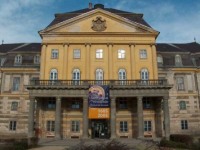
The Batthyány family was one of the largest landowners in southwest Hungary, whose land holdings also included areas now in Burgenland, Austria. They encouraged Jews to settle in their territories, and major communities developed in Nagy-Kanizsa, Körmend, Güssing, Rechnitz and Schlaining. In exchange for the right of settlement, they collected a special tax, called the "Tolerance tax" from their "protected" Jews. Until around 1840, Jews were guaranteed a certain amount of autonomy and self-administration--they could elect their own council, judges and a jury which monitored adherence to religious laws, had jurisdiction over minor offenses and complaints of Christians against Jews.
Originally a royal estate, after passing through the hands of a queen and several magnates, the estate became a possession of the Batthyány family in 1604.
The palace, built in the Baroque style, was designed by the famous Italian architect Donato Felica de Allio and built on the foundation of the town's medieval castle. The large building complex acquired its present form between 1730 and 1745.
After 1716, the palace became the administrative center for all the Batthyány estates.
The gardens around the castle were originally laid out in the French style in the 1700s, but redesigned as an English landscape garden during the 1800s. Today, they comprise a 37 hectare nature reserve that is open to the public with reputedly some of the finest magnolias in all of Hungary.
Currently, the palace houses several museums. The Rába Museum of Local History (named for the river that runs through the town) contains WWI mementos, handicrafts, old machinery and other items. There is an adjoining shoe museum, which is the only museum in Hungary devoted to the history of shoes and footwear. The palace also houses a museum named for Dr. László Batthyány-Strattman, who lived from 1870 - 1931 and was the last owner of the palace. Dr. Batthyány-Strattman was known as the "physician of the poor" as he treated patients for free. He was beatified by the Catholic Church in 1992. The museum contains treasures of natural history, archeological exhibits from prehistoric and Copper Age times, as well as artifacts of the Batthyány family, including the 16th century will of Ferenc Batthyány.
In the Batthyány Library there is allegedly a fragment of the codex of Rabbi Jacob Ben Asher's Tur, which was used as the binding board of a socage register. It was allegedly in possession of the Batthyány family as early as 1541, having passed to Körmend from Sopron after the expulsion of the Jews in 1526.
Webmaster notes:
Rabbi Jacob Ben Asher (ca. 1269, Cologne, Germany - ca. 1343, Toledo, Spain), an influential Medieval rabbinic authority. His main halachic work was the Arba'ah Turim "Four Rows", named so as it was divided into four sections, each one called a "tur", in reference to the rows of jewels on the High Priest's breastplate.
Socage: a form of feudal land tenure in which the tenant lived on the lord's land and in return rendered a certain agricultural service or payment of rent.
codex: A precursor of the bound book, developed in the second century C.E. to replace the old form of the roll, which could only be written on one side. A codex would consist of a designated number of parchment sheets (cattle hides treated so that both sides were suitable for writing) that were stitched together and folded, and a binding board, or cover. To ensure durability, binding boards were often padded with the worn out (or in the case of some Jewish manuscripts, confiscated) parchment of other codices or manuscripts.
Return to Körmend main page
© Copyright 2008 Judy
Petersen
 |